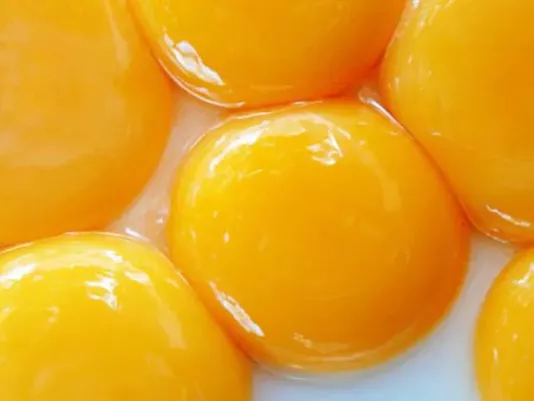Turkish Samsa with Chicken and Cheese
Turkish samsa with chicken and cheese - excellent samsa made from delicate shortcrust pastry with juicy chicken filling.

Egg yolk is a concentrate of nutrients and flavor depth that can change a dish’s structure without aggressive interference. In my practice, it is the yolk that determines the stability of a sauce, the tenderness of dough, or the silkiness of cream. Its chemical composition – a natural blend of water, fats, and lecithin – creates ideal conditions for emulsification, which is why I always use it in homemade mayonnaise or custard. It’s important that the yolk is fresh and at room temperature: this prevents separation and ensures even whipping. Over the years, I’ve noticed that even the color of the yolk can change the impression of a dish: a rich yellow makes pastries more appealing, while a pale one dulls the flavor. That’s why I carefully choose eggs, especially for desserts where every detail matters.
Over the years of cooking, I’ve learned to assess yolk quality not just by the date on the carton but by its appearance. A fresh egg has a firm, elastic yolk that holds its shape and doesn’t spread across the surface. If the color is too dull or the yolk watery, the egg is old. I always test eggs in water: fresh ones stay at the bottom, while those stored too long float. I’ve also noticed that farm eggs have a deeper hue and a denser membrane, allowing them to withstand heat better. For creams and sauces, I prefer those because they whip more stably and don’t separate during emulsification. When storing yolks separately, I lightly sprinkle them with sugar or salt to prevent a skin from forming. I always take eggs out of the refrigerator in advance, since cold yolks whip unevenly and combine poorly with butter or syrup. For baking, this is critical, so checking the temperature beforehand has become a rule that guarantees consistent results.
Before working with yolks, I always separate the eggs over a clean bowl, avoiding even a drop of white, as it can ruin the emulsion or prevent proper whipping. If a yolk breaks accidentally, I don’t use it for mousses or creams that require precision, but instead add it to baked goods or sauces. Over the years, I’ve learned that the key is cleanliness and care, especially when preparing cold sauces, since even a microcrack in the shell can introduce unwanted bacteria. For the safe use of raw yolks, I often heat them to 60°C (140°F) in a water bath, stirring constantly until the mixture becomes smooth – this preserves flavor and minimizes risk. When beating yolks with sugar, I use a metal or glass bowl: plastic retains fat, which affects texture. When adding yolks to hot syrup or milk, I always do it gradually, pouring in a thin stream to avoid curdling. This skill has saved me many times when making delicate crème brûlée or custard, where precision is the key to success.
Yolk is extremely sensitive to temperature, and this is where mistakes most often occur. When overheated, protein coagulation begins around 65°C (149°F), causing the cream or sauce to become lumpy. I always use low heat and constant stirring to stay in control. When preparing a custard base, I watch the spatula: once the mixture coats it evenly, that’s the sign the temperature is right. In my experience, it’s important not only to avoid overcooking but also underheating, as then the yolk won’t bind the liquid and the texture will remain watery. For dishes like carbonara, I rely on the residual heat of the pasta – enough to achieve a delicate creaminess without direct heating. For baked goods where yolk is part of the dough, I consider that its fats affect structure, making the crumb denser and more aromatic. When I need elasticity or shine in a glaze, I add a small amount of yolk instead of extra fat – this ensures natural balance and a stable texture after cooling.
In my kitchen, the yolk is a universal mediator between water and fat. It pairs beautifully with butter, oil, sugar, milk, and even alcohol-based infusions, forming a stable mixture. When making a sauce, I add an acidic component – lemon juice or vinegar – to help lecithin work more efficiently. In desserts, I focus on the balance between sweetness and richness: too much sugar dulls the yolk’s aroma, while excess fat makes the mixture heavy. In sauces for fish or vegetables, I combine yolk with mustard – it aids emulsification. Over the years, I’ve found that freshly beaten yolks retain air bubbles better if you add a pinch of salt before whipping. For mousses and creams, this greatly affects lightness of texture. I also avoid mixing with acids without stabilizers – that destroys the structure. In baking, yolk pairs wonderfully with vanilla and citrus zest, enhancing aroma without overpowering the main flavor. All this makes it not just an ingredient but a key to harmony of taste and texture.
The most common mistake is haste. People often overheat yolks, thinking that the faster the mixture thickens, the better. In fact, this leads to separation and an unpleasant smell. I always tell my students: patience is the main spice of cooking. Another mistake is working with cold ingredients, when yolk doesn’t mix evenly and forms lumps. You should also avoid aluminum cookware: reaction with acids alters color and taste. If the emulsion still breaks, I gradually add a teaspoon of warm water while whisking continuously – this almost always saves it. I’m also careful about storage: yolks don’t tolerate open air, so I cover them tightly with plastic wrap to prevent drying. Quality control is simple – a uniform texture, no off-odor, and natural gloss. Through years of practice, I’ve learned that control isn’t about the number of measurements but about attention to detail. It’s that attentiveness that makes any dish stable and predictable, even when cooked by intuition.